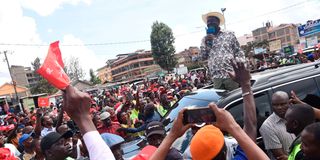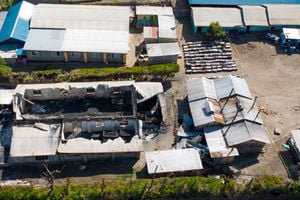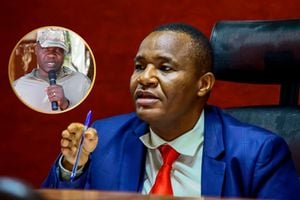Is Kenya’s opposition hitting the self-destruct button?

Azimio leader Raila Odinga at Fagilia Grounds in Utawala, Nairobi, on Sunday. He called on Kenyans to come out in large numbers for the December 7 rally at Kamukunji Grounds.
Manifestly, the future of Kenya’s opposition looks uncertain. A strident return to confrontational strategies is, tragically, polarising post-election politics and widening the gap between President William Ruto’s nascent administration and the main opposition, the Azimio la Umoja One Kenya Coalition.
On December 7, 2022, Azimio’s kingpin, Raila Odinga, launched a high-pitched, almost frantic, 30-day campaign of street protests against Dr. Ruto’s administration — now on its 88th day in office. Is Kenya’s opposition rising or falling? Is it getting more strategic, or simply hitting the self-destruct button?
Elsewhere, academics and policy thinkers are applauding “the rise of the opposition in Africa” and fretting “the likely fall” of more and more governments. In an ironic twist, Dr. Ruto’s victory in Kenya’s August 9, 2022 General Election signify the epic rise of more strategic opposition parties in Africa, which are everywhere dethroning incumbents.
In Malawi, the incumbent, Peter Mutharika, fell to Lazarus Chakwera and his Tonse Alliance in June 2020. In August 2021, Zambia’s opposition doyen, Hakainde Hichilema and his United Party of National Development (UPND), defeated the incumbent, President Edgar Lungu. And in Somalia, Hassan Sheikh Mohamoud (HSM) trounced the incumbent, president Mohamed Abdullahi Farmajo, in May 2022.
Handshake
To be sure, Dr. Ruto is not your typical opposition leader. He was Kenya’s Deputy President in the 2013-2022 decade. However, his fervent opposition to the “handshake” (informal power-sharing deal) between Kenyatta and Odinga from March 2018 turned him into Kenya’s de facto opposition candidate in August 2022.
Ruto erected Kenya’s most strategic, well-oiled, ideologically cohesive, class-based and cross-ethnic opposition deus ex machina. This enabled him to defeat a combined fighting force of the incumbent, Uhuru Kenyatta, and the ‘Official Opposition’ of Raila Odinga.
After Ruto’s strategic opposition captured the presidency and established Kenya’s fifth republic, a weak, organisationally underdeveloped, under-resourced and ethically fragmented opposition is the weakest link in Kenya’s democracy. A clear-eyed rendition of the opposition as the Achilles’ heel of emerging democracies was the strikingly missing piece in Professor Makau Mutua’s polemics against “Kenya’s Fake Democracy” (Sunday Nation Oct 30-Nov. 20, 2022).
Three factors are irreversibly changing the face of Kenya’s opposition.
One is a growing public disenchantment with protests and other confrontational strategies. True, democracy requires strong opposition parties. The country’s opposition and its intellectuals continue to cling on to the run-of-the-mill thinking that “party-building is more effective where it intensifies conflict.”
This thinking has led to outmoded and divisive and adversarial tactics that weaken rather than strengthen opposition parties, spawned violence, destruction of property and raised the risk of an authoritarian backlash.
Kenya needs a loyal opposition as a public watch-dog and government-in-waiting that challenges the actions of the governing parties/coalition and sitting cabinet while remaining loyal and true to the constitution as the basis of the government's power.
Second is a backlash against post-election power-sharing deals that weaken opposition parties. Since the 1992 multi-party election, losers in elections have routinely and unabashedly resorted to confrontational strategies to force the winner to share executive power.
Post-election power-sharing deals have become a poisoned chalice for the opposition. Kenya is littered with skeletons of parties that have fallen to power-sharing deals. Reading the new memoir, Sheer Grit: A Memoir” (2002) by Senator Zipporah Kittony, power-sharing as a strategy of securing power after losing an election can be traced to the “efforts by Raila’s father, Jaramogi Oginga Odinga, to cooperate with Kanu” after losing the 1992 presidential contest.
Jaramogi, who convened all Luo MPs to a meeting where he expressed his intention to work with President Moi, saw a handshake with Moi as “a way of ensuring that the community was not left out of decision-making and sharing of the national pie.” Odinga died in 1994 before his Ford-Kenya was to enter into a coalition with Kanu.
Presidential candidate
Immediately after the general elections in 1997, Raila and his National Development Party (NDP) entered into a cooperation agreement with Moi. Raila and a host of other Luo MPs were appointed to Moi’s Cabinet. On March 18, 2002, NDP was merged to Kanu in what turned out NDP’s kiss of death. However, Raila abandoned Kanu and re-joined the opposition protesting against Moi’s decision to endorse Uhuru Kenyatta as the ruling party’s presidential candidate. KANU became an opposition party after Uhuru Kenyatta lost to Mwai Kibaki and NARC in 2002.
The claim of a “stolen election” and refusal to concede defeat has become the strategy of choice for mobilising supporters around a radical political agenda and to justify protests. The tragic 2007-2008 post-election violence forced Kibaki to share power with Raila’s ODM in a Grand Coalition Government.
After the controversial “double elections” in August and October 2017, Odinga intensified protests and even swore himself as “People’s President.” Kenyatta caved in and entered into a “handshake” (informal power-sharing) with Raila in March 2018. The handshake split his Jubilee party and Raila’s opposition right through the middle.
After his election, Ruto declared that he would not have a handshake with Raila, rejecting the power-sharing model of post-election governance. This is for obvious reasons. Ruto was the ultimate victim of the Kibaki-Odinga handshake (2008) and the Kenyatta-Odinga handshake in 2018. Second, a handshake with Odinga would scuttle the delicate Kenya Kwanza ‘broad church’ or ‘Big-Tent’ coalition on which he rode to power.
Presidential candidate
Third, a growing public demand for a functioning and effect opposition as a political counterweight to the victorious party and president. The post-election environment has created a rare chance to build a strong opposition. Upon election, Dr. Ruto backed the idea of a strong opposition to keep his administration in check and help push the government to deliver on its promises to the people.
On December 6, 2022, the president instructed the Members of Parliament from his Kenya Kwanza Coalition to table a bill that gives the leader of the opposition constitutional powers to execute their duties as an effective opposition. This will require amendment of Article 260 of the Constitution to include the office of the leader of opposition under the category of “state office” thereby, rendering it a powerful position.
As for now, Odinga should shun polarizing confrontational strategies, appoint Azimio’s 22 shadow Cabinet Secretaries (CSs) to oversight Ruto’s ministries and embark on transforming the opposition into a strong and strategic public watchdog with teeth.
Professor Peter Kagwanja is former Government Adviser, the Chief Executive at the Africa Institute (API) and Adjunct Scholar at the University of Nairobi and the National Defence University (NDU), Kenya.





